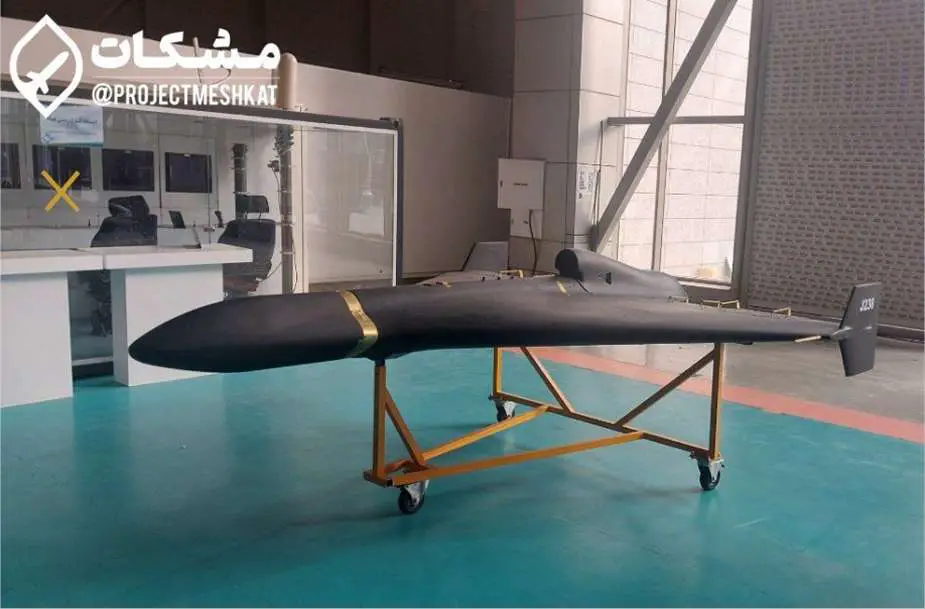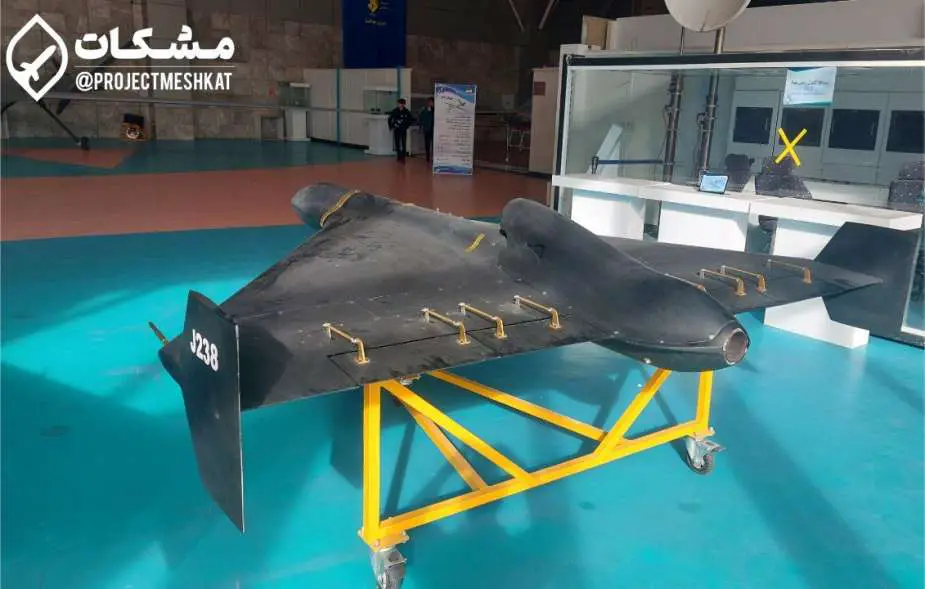Breaking news
Could Iran's Shahed-238 jet-powered kamikaze drone give Russia an advantage in Ukraine?.
On December 28, 2023, Meshkat published new images of one of Iran's recent military developments, the Shahed-238 jet-powered kamikaze drone, officially unveiled by Iran's Ashura University of Aerospace Sciences and Technologies on November 22, 2023. The Shahed-238 is an upgraded version of the Shahed-136 kamikaze drone, used by Russia in Ukraine, and it incorporates significant enhancements.
Follow Army Recognition on Google News at this link

The Shahed-238 jet-powered kamikaze drone is an improved version of the Iranian Shahed-136 kamikaze drone, also known as Geran-2 in Russia. (Picture source: Twitter/Meshkat)
On November 22, 2023, an exhibition showcased three different versions of the Shahed-238, each equipped with distinct guidance systems. Alongside the standard model, which features an autonomous guidance system based on inertial navigation and GPS signals (the middle version), there were variants with infrared/optical and presumably radar guidance systems on display as well.
The version equipped with an infrared/optical guidance system is designed for targeting heat-contrast objects, particularly crucial military equipment in the enemy's rear. Meanwhile, the drone with a radar guidance head could serve a similar purpose as anti-radar missiles, targeting emissions from search radars. This capability could be used to counter enemy air defense systems.
All three drones have noticeably black fuselages, which may suggest the use of radar-absorbing materials, although there hasn't been official confirmation of this yet. It's worth noting that these drones have undergone design modifications compared to the previously displayed prototype, where the optical station was mounted under the front fuselage.
However, specific technical specifications of the Shahed-238 remain undisclosed. Its jet engine is expected to offer high speed but may come at the expense of reduced flight range. During the prototype demonstration, a launch from a moving vehicle was demonstrated. Nevertheless, like its predecessor, the Shahed-136, it is anticipated that the drone can still be launched from a stationary platform using a solid-fuel booster.
One notable improvement over the Shahed-136 is the Shahed-238's potential for autonomous navigation to its targets, increasing its operational flexibility compared to the manual operation required by the older prototype. This enhancement will extend its range and reduce the need for relay stations near the target.
From a military perspective, the deployment of the Shahed-238 jet-powered kamikaze drone by Russia on the Ukrainian battlefield could offer several advantages compared to the Shahed-136 actually used.
Visually, the Shahed-238 introduces several significant enhancements, such as an engine cover and an increased number of actuators. The engine cover has the potential to enhance the drone's aerodynamics, potentially affecting its speed, maneuverability, and fuel efficiency—critical factors in military drone applications. Additionally, it may reduce the drone's radar and infrared signatures, making it less detectable by enemy radar and infrared sensors.
The inclusion of eight actuators, as opposed to the four found in the Shahed-136, represents another key difference. Actuators play a vital role in controlling various aspects of a drone's flight, including stability, maneuverability, and payload handling. This increase in actuators offers improved stability, finer control over the drone's movements, and enhanced resistance to external disturbances.
The added actuators also contribute to enhanced maneuverability, enabling the Shahed-238 to execute more precise and intricate maneuvers, which can be advantageous for tasks like targeting fast-moving military vehicles. Furthermore, the redundancy introduced by doubling the number of actuators enhances the drone's resilience in case of actuator failure, potentially reducing the risk of accidents or crashes. Lastly, the increased number of actuators may enable the Shahed-238 to carry heavier payloads, potentially enhancing its mission capabilities.
To conclude, the Shahed-238 represents a significant development in Iran's kamikaze drone technology, with the inclusion of a jet engine, improved guidance systems, stealth capabilities, and enhanced aerodynamics, all of which contribute to a more capable drone. The potential advantages over its predecessor make it a military drone worth monitoring closely on the global stage, especially if Russia begins using it in Ukraine. In fact, Russian troops might find the improvements offered by the Shahed-238 compared to the Shahed-136 valuable for various military operations, including targeted strikes deep within Ukrainian territory.

Compared to its predecessor, the Shahed-136, the Shahed-238 offers several improvements, including the engine covering and the doubling of actuators (8 instead of 4). (Picture source: Twitter/Meshkat)


























